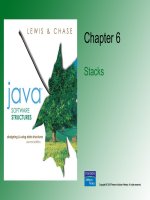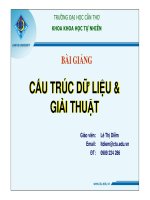Bài giảng Cấu trúc dữ liệu_ Phần Tree
Bạn đang xem bản rút gọn của tài liệu. Xem và tải ngay bản đầy đủ của tài liệu tại đây (2.2 MB, 78 trang )
Chapter 12
Trees
Copyright © 2005 Pearson
Addison-Wesley. All rights
reserved. 12-2
Chapter Objectives
•
Define trees as data structures
•
Define the terms associated with trees
•
Discuss the possible implementations of trees
•
Analyze tree implementations of collections
•
Discuss methods for traversing trees
•
Examine a binary tree example
Copyright © 2005 Pearson
Addison-Wesley. All rights
reserved. 12-3
Trees
•
A Tree is a non-linear structure defined
by the concept that each node in the
tree, other than the first node or root
node, has exactly one parent
•
For trees, the operations are
dependent upon the type of tree and
it’s use
Copyright © 2005 Pearson
Addison-Wesley. All rights
reserved. 12-4
Definitions
•
In order to discuss trees, we must first have
a common vocabulary
•
We have already introduced a couple of
terms:
–
node which refers to a location in the tree where
an element is stored, and
–
root which refers to the node at the base of the
tree or the one node in the tree that does not
have a parent
Copyright © 2005 Pearson
Addison-Wesley. All rights
reserved. 12-5
Definitions
•
Each node of the tree points to the nodes that are
directly beneath it in the tree
•
These nodes are referred to as its children
•
A child of a child is then called a grandchild, a child
of a grandchild called a great-grandchild
•
A node that does not have at least one child is
called a leaf
•
A node that is not the root and has at least one child
is called an internal node
Copyright © 2005 Pearson
Addison-Wesley. All rights
reserved. 12-6
FIGURE 12.1 Tree terminology
Copyright © 2005 Pearson
Addison-Wesley. All rights
reserved. 12-7
Definitions
•
Any node below another node and on a path from
that node is called a descendant of that node
•
Any node above another node on a connecting path
from the root to that node is called an ancestor of
that node
•
All children of the same node are called siblings
•
A tree that limits each node to no more than n
children is called an n-ary tree
Copyright © 2005 Pearson
Addison-Wesley. All rights
reserved. 12-8
Definitions
•
Each node of the tree is at a specific level or depth within the
tree
•
The level of a node is the length of the path from the root to
the node
•
This pathlength is determined by counting the number of links
that must be followed to get from the root to the node
•
The root is considered to be level 0, the children of the root are
at level 1, the grandchildren of the root are at level 2, and so
on
Copyright © 2005 Pearson
Addison-Wesley. All rights
reserved. 12-9
Definitions
•
The height or order of a tree is the length of
the longest path from the root to a leaf
•
Thus the height or order of the tree in the
next slide is 3
•
The path from the root (A) to leaf (F) is of
length 3
•
The path from the root (A) to leaf (C) is of
length 1
Copyright © 2005 Pearson
Addison-Wesley. All rights
reserved. 12-10
FIGURE 12.2 Path length and level
Copyright © 2005 Pearson
Addison-Wesley. All rights
reserved. 12-11
Definitions
•
A tree is considered to be balanced if all of the
leaves of the tree are at roughly the same depth
•
While the use of the term “roughly” may not be
intellectually satisfying, the actual definition is
dependent upon the algorithm being used
•
Some algorithms define balanced as all of the
leaves being at level h or h-1 where h is the height
of the tree (where h = log
N
n for an N-ary tree)
Copyright © 2005 Pearson
Addison-Wesley. All rights
reserved. 12-12
FIGURE 12.3 Balanced
and unbalanced trees
Copyright © 2005 Pearson
Addison-Wesley. All rights
reserved. 12-13
Definitions
•
The concept of a complete tree is related to the
balance of a tree
•
A tree is considered complete if it is balanced and all
of the leaves at level h are on the left side of the tree
•
While a seemingly arbitrary concept, as we will
discuss in later chapters, this definition has
implications for how the tree is stored in certain
implementations
•
Trees a and c on the next slide are complete while
tree b is not
Copyright © 2005 Pearson
Addison-Wesley. All rights
reserved. 12-14
FIGURE 12.4 Some complete trees
Copyright © 2005 Pearson
Addison-Wesley. All rights
reserved. 12-15
Implementing Trees with Links
•
While it is not possible to discuss the details of an
implementation of a tree without defining the type of
tree and its use, we can look at general strategies for
implementing trees
•
The most obvious implementation of tree is a linked
structure
•
Each node could be defined as a TreeNode class, as
we did with the LinearNode class for linked lists
Copyright © 2005 Pearson
Addison-Wesley. All rights
reserved. 12-16
Implementing Trees with Links
•
Each node would contain a pointer to the
element to be stored in that node as well
as pointers for each of the possible
children of the node
•
Depending on the implementation, it may
also be useful to store a pointer in each
node to its parent
Copyright © 2005 Pearson
Addison-Wesley. All rights
reserved. 12-17
Implementing Trees with Arrays
•
For certain types of trees, specifically binary
trees, a computational strategy can be used for
storing a tree using an array
•
For any element stored in position n of the
array, that elements left child will be stored in
position ((2*n) + 1) and that elements right
child will be stored in position (2*(n+1))
Copyright © 2005 Pearson
Addison-Wesley. All rights
reserved. 12-18
Implementing Trees with Arrays
•
This strategy can be managed in terms of capacity in
much the same way that we did for other array-based
collections
•
Despite the conceptual elegance of this solution, it is
not without drawbacks
•
For example, if the tree that we are storing is not
complete or relatively complete, we may be wasting
large amounts of memory allocated in the array for
positions of the tree that do not contain data
Copyright © 2005 Pearson
Addison-Wesley. All rights
reserved. 12-19
FIGURE 12.5 Computational strategy
for array implementation of trees
Copyright © 2005 Pearson
Addison-Wesley. All rights
reserved. 12-20
Implementing Trees with Arrays
•
A second possible array implementation of trees is
modeled after the way operating systems manage
memory
•
Instead of assigning elements of the tree to array
position by location in the tree, array positions are
allocated contiguously on a first come first served
basis
•
Each element of the array will be a node class similar
to the TreeNode class that we discussed earlier
Copyright © 2005 Pearson
Addison-Wesley. All rights
reserved. 12-21
Implementing Trees with Arrays
•
However, instead of storing object reference
variables as pointers to its children (and perhaps its
parent), each node would store the array index of
each child (and perhaps its parent)
•
This approach allows elements to be stored
contiguously in the array so that space is not wasted
•
However, this approach increases the overhead for
deleting elements in the tree since either remaining
elements will have to be shifted to maintain contiguity
or a free-list will have to be maintained
Copyright © 2005 Pearson
Addison-Wesley. All rights
reserved. 12-22
FIGURE 12.6 Simulated link strategy for
array implementation of trees
Copyright © 2005 Pearson
Addison-Wesley. All rights
reserved. 12-23
Analysis of Trees
•
Trees are a useful and efficient way to implement
other collections
•
In our analysis of list implementations in Chapter 8, we
described the find operation as expected case n/2 or
O(n)
•
However, if we implemented an ordered list using a
balanced binary search tree, a binary tree with the
added property that the left child is always less than
the parent which is always less than or equal to the
right child, then we could improve the efficiency of the
find operation to O(log n)
Copyright © 2005 Pearson
Addison-Wesley. All rights
reserved. 12-24
Analysis of Trees
•
This is due to the fact that the height or order
of such a tree will always be log
2
n where n is
the number of elements in the tree
•
This is very similar to our discussion of binary
search in Chapter 11
•
In fact, for any balanced N-ary tree with n
elements, the tree’s height will be log
N
n
•
With the added ordering property of a binary
search tree, you are guaranteed to at worst
search one path from the root to a leaf
Copyright © 2005 Pearson
Addison-Wesley. All rights
reserved. 12-25
Tree Traversals
•
There are four basic algorithms for
traversing a tree:
–
Preorder traversal
–
Inorder traversal
–
Postorder traversal
–
Levelorder traversal









